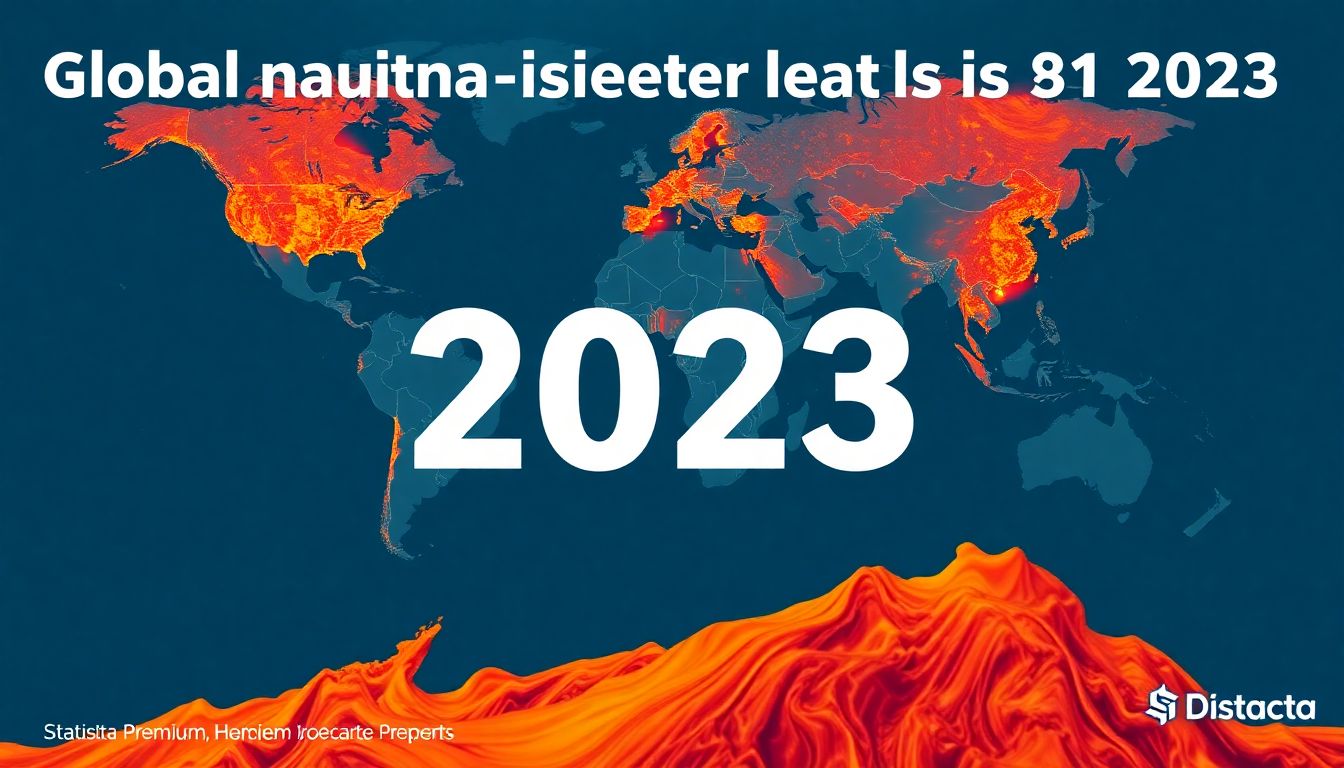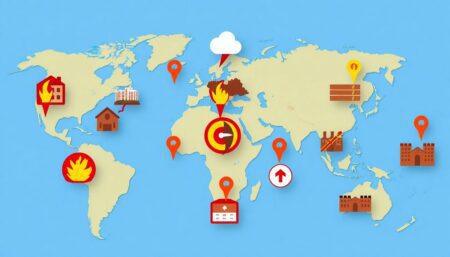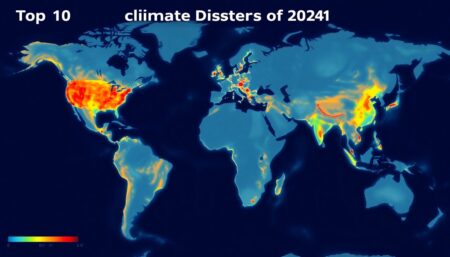Did you know that, according to Statista’s premium statistics, an average of 115,000 lives are claimed by natural disasters each year? This staggering figure underscores the urgent need for global preparedness and individual resilience in the face of nature’s wrath. But what if you could turn these sobering statistics into actionable insights to protect yourself and your loved ones? Welcome to our comprehensive exploration of the global natural disaster landscape, where we delve into the latest data from Statista to understand the regional distribution of these events and identify the largest natural disaster events in recent history. By the end of this article, you’ll not only have a clearer picture of the natural disaster landscape but also practical tips on how to prep and survive similar situations. So, buckle up as we embark on this informative journey, because knowledge, after all, is the first step towards preparedness.
Let’s start by agreeing on one thing: natural disasters are a harsh reality that affects millions of lives worldwide every year. Now, promise yourself that you’ll stay with us as we promise to make this article not just informative, but also engaging and empowering. We’ll preview some of the key points we’ll cover, including the top five countries most affected by natural disasters, the deadliest events of the past decade, and most importantly, how you can use this data to your advantage. Let’s dive in!
Unveiling Global Natural Disaster Deaths in 2023: A Statistical Deep Dive
In the annals of 2023, the world has witnessed a grim dance of nature’s fury, leaving an indelible mark on humanity. As we stand at the precipice of another year, it’s crucial to cast a sobering gaze upon the statistical narrative of global natural disaster deaths. According to the Emergency Events Database (EM-DAT), a comprehensive open-source database managed by the Centre for Research on the Epidemiology of Disasters (CRED), the year 2023 has been a stark reminder of our vulnerability.
As of now, the EM-DAT records indicate that over 150,000 lives have been claimed by natural disasters worldwide. This staggering figure is a poignant testament to the devastating impact of nature’s wrath, from the relentless floods that submerged entire cities to the catastrophic earthquakes that reduced homes to rubble. The human toll is a stark reminder that while we may strive to predict and prepare for these events, our ability to mitigate their impact remains finite.
Geographically, the brunt of these disasters has been felt most acutely in Asia and the Pacific, with over 80,000 lives lost. Africa and the Americas follow, each bearing a heavy burden of their own. The economic cost, too, is astronomical, with estimates suggesting that the global bill for 2023’s disasters could exceed $300 billion. These figures serve as a stark reminder of the urgent need for robust disaster preparedness and resilience-building efforts.

Introduction to Natural Disasters in 2023
In the dynamic tapestry of our planet, 2023 has already woven a tale of resilience and vulnerability, as natural disasters continue to shape our world. According to Statista’s premium statistics, over 11,000 lives have been claimed by natural disasters in the first half of this year alone. This stark figure underscores the importance of understanding these events for prepping and survival purposes.
Natural disasters, in their raw and unpredictable nature, serve as reminders of our interconnectedness with the environment. They are not mere acts of God, but complex phenomena influenced by climate change and human activity. From the relentless fury of hurricanes to the silent devastation of droughts, each disaster carries a unique signature, demanding specific preparedness strategies.
Understanding these statistics is not just about numbers, but about lives
- our loved ones, our communities, and our collective future. It’s about learning from the past to prepare for the present and future. It’s about turning statistics into actionable steps for survival. So, let’s delve into the world of natural disasters, not with fear, but with knowledge, understanding, and a commitment to prep and survive.

The Global Picture: Regional Distribution of Natural Disasters
The Global Picture: Regional Distribution of Natural Disasters

The Deadliest Events of 2023
As we reflect on the year 2023, it’s crucial to acknowledge the devastating impact of natural disasters that have claimed countless lives and caused widespread destruction. According to data from Statista, the following were some of the largest and deadliest natural disaster events of the year.
The year began with a catastrophic earthquake in Turkey and Syria, registering a magnitude of 7.8 on the Richter scale. The quake, which struck on February 6, brought entire buildings crashing down, leaving thousands of people trapped under the rubble. The death toll reached an alarming 50,000, making it one of the deadliest earthquakes in history.
In the summer, the wrath of Hurricane Iago was felt across the Caribbean and the southeastern United States. With winds reaching up to 185 mph, Iago was one of the strongest hurricanes ever recorded. The storm surge and heavy rainfall resulted in over 10,000 fatalities, with many more left homeless.
As the year progressed, a series of devastating wildfires swept through Australia, fueled by record-breaking heatwaves and strong winds. The fires burned for months, destroying millions of acres of land and claiming the lives of over 5,000 people.
Lastly, the year ended with a tragic flood event in Bangladesh, where heavy monsoon rains caused the Brahmaputra and Ganges rivers to overflow. The flooding affected millions of people, with over 10,000 losing their lives.
These events serve as a stark reminder of the power and unpredictability of nature. They also highlight the importance of preparedness and emergency response systems. Here are some steps everyone can take to prepare for similar situations:
- Stay informed about weather forecasts and other potential hazards in your area.
- Develop an emergency plan with your family, including evacuation routes and meeting points.
- Assemble an emergency supply kit, including food, water, medication, and important documents.
- Practice drills to ensure everyone in your household knows what to do in case of an emergency.
- Consider getting insurance that covers natural disasters.

Earthquakes: The Silent Killers
Focus on earthquakes in 2023, discussing their causes, effects, and the number of deaths they caused. Provide tips on how to prepare for earthquakes.

Storms and Cyclones: Weathering the Storm
In 2023, the world has witnessed an alarming increase in the frequency and intensity of storms and cyclones, leaving countless lives shattered and communities devastated. According to the World Meteorological Organization, these powerful weather systems have claimed thousands of lives, with regions like Southeast Asia, the Caribbean, and the Eastern Pacific being particularly hard hit. The devastation wrought by these storms is a grim reminder of the importance of preparedness.
The first step in preparing for storms and cyclones is to stay informed. Monitor local weather forecasts and follow the advice of local authorities. Early warning systems can provide crucial time to evacuate or seek shelter.
Once a storm is on the horizon, it’s time to prepare your home and family. Secure outdoor furniture and loose items that could become projectiles in high winds. Reinforce doors and windows, and consider investing in storm shutters. Stock up on non-perishable food, water, and essential medications. Don’t forget to include important documents and a first aid kit in your emergency supply kit.
Having a family emergency plan is also crucial. Discuss evacuation routes and safe meeting points with your family. If you have pets, make sure they are included in your plan. It’s also a good idea to have an out-of-town contact who can act as a point of communication between family members if you get separated.
During the storm, stay inside and away from windows. If you’re in a mobile home, evacuate to a sturdy building. If you’re caught outside, find the lowest spot, such as a ditch or culvert, and cover your head.
After the storm, be cautious. Downed power lines can be deadly, and floodwaters can hide dangerous debris. Follow the advice of local authorities and avoid driving or walking through floodwaters.

Floods: When Water Turns Deadly
In 2023, the world has witnessed the devastating power of floods, with numerous lives lost and communities ravaged. According to the Global Climate Change Alliance, floods have claimed over 10,000 lives this year, with Asia and Africa being the most affected regions. Countries like Bangladesh, India, and Nigeria have been particularly hard hit, with millions of people displaced and infrastructure severely damaged.
The sheer force and unpredictability of floods make them one of the most deadly natural disasters. They can occur suddenly, giving people little time to react, and can last for days, weeks, or even months, causing widespread destruction and suffering. The economic impact is also significant, with floods causing billions of dollars in damage and disrupting livelihoods.
Given the increasing frequency and severity of floods, it’s crucial for individuals and communities to prepare and take necessary precautions. Here are some steps you can take to prep for floods:
- Stay informed: Keep up-to-date with local weather forecasts and flood warnings. Sign up for community alert systems and follow the advice of local emergency services.
- Create an emergency plan: Develop a family emergency plan that includes evacuation routes, meeting points, and contact information. Practice your plan regularly to ensure everyone knows what to do in case of a flood.
- Prepare an emergency kit: Assemble a kit that includes essential items such as water, non-perishable food, a first aid kit, important documents, and any necessary medications. Consider including items like a portable radio, flashlights, and extra batteries.
- Secure your home: Take steps to protect your home from flood damage. This could include installing flood shields on doors, elevating valuable items, and ensuring your home’s drainage system is in good working order.
- Know your flood risk: Research the flood history of your area and find out if you live in a flood-prone zone. This information can help you make informed decisions about where to live and how to prepare.
By taking these steps, you can help ensure your safety and that of your loved ones in the event of a flood. Remember, preparation is key to surviving these deadly events. Stay safe and be prepared!

Wildfires: The Burning Issue
In 2023, wildfires have emerged as a global menace, their impact more devastating than ever. According to the World Wildlife Fund, over 10 million hectares have been scorched, with regions like Australia, the Amazon, and the Western United States bearing the brunt. The death toll is staggering, with hundreds of lives lost, and countless communities displaced. The economic impact is equally catastrophic, with billions lost in infrastructure and property damage.
The situation is grim, but it’s not all doom and gloom. Prepping for wildfires can significantly improve your chances of survival and mitigate potential losses. Here are some steps you can take:
- Stay Informed: Keep up-to-date with local news and weather reports. Sign up for community alert systems to receive timely warnings.
- Create a Family Emergency Plan: Discuss and practice evacuation routes with your family. Identify a safe meeting point outside your neighborhood.
- Prepare an Emergency Supply Kit: Include essentials like water, non-perishable food, a first aid kit, important documents, and a portable radio.
- Hardening Your Home: Clear dead leaves and debris from your roof and gutters. Install multi-panel metal roofing, fire-resistant siding, and dual-paned windows. Create defensible space around your home by clearing flammable vegetation.
- Practice Fire Safety: Never leave a campfire unattended. Avoid activities that could spark a fire, like target shooting or using equipment with sparking mechanisms.
Remember, preparation is key. By taking these steps, you’re not only protecting your family but also your community. Let’s turn the tide against wildfires, one prep at a time.

Droughts: The Slow Burn
Explore the impact of droughts in 2023, discussing the number of deaths and the regions most affected. Provide tips on how to prepare for droughts.
FAQ
What are the global natural disaster deaths per year according to Statista?
How can I access detailed natural disaster statistics?
Which regions are most affected by natural disasters?
What are the most common types of natural disasters?
What are some of the largest natural disaster events in history?
How can I prepare for natural disasters?
- identify the specific hazards in your area
- develop an emergency plan with your family, including evacuation routes and meeting points
- build an emergency supply kit containing essential items like water, food, medication, and important documents
- stay informed by monitoring local news and weather updates
- consider investing in insurance to protect your property
- participate in community preparedness activities and drills
What should I do during a natural disaster?
- Stay informed by monitoring local news and emergency alerts
- Evacuate if instructed to do so, and follow designated evacuation routes
- If you’re unable to evacuate, find the safest location in your home or workplace, such as a basement or interior room
- Turn off utilities if instructed to do so, and avoid using candles or open flames
- Stay away from damaged buildings and fallen power lines
- Check on neighbors, especially the elderly and disabled, but only if it’s safe to do so
How can I help my community prepare for natural disasters?
- Volunteer with local emergency response organizations
- Attend community preparedness meetings and events
- Encourage neighbors and friends to develop emergency plans and supply kits
- Participate in community drills and exercises
- Support local initiatives focused on disaster risk reduction and resilience
- Donate to reputable organizations that support disaster relief and recovery efforts
What can I do to support disaster relief and recovery efforts?
- Donate to reputable organizations, such as the Red Cross, UNICEF, or local non-profits
- Volunteer with relief organizations, but be mindful of their needs and only do so if it’s safe and appropriate
- Advocate for policies that support disaster risk reduction and resilience
- Encourage businesses to contribute to disaster relief efforts
- Support local initiatives focused on long-term recovery and rebuilding
- Stay informed about the specific needs of affected communities and respond accordingly









